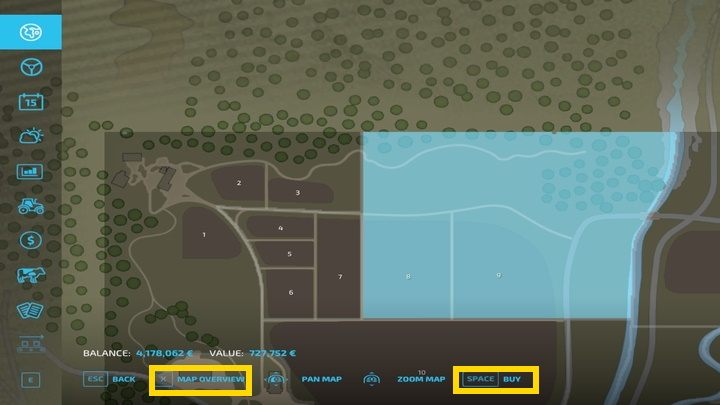Farming Simulator 22: How to buy field and what to pay attention to?
The following guide page will explain how to acquire new fields in Farming Simulator 22.
Last update:
On this guide page to Farming Simulator 22, you will learn how to acquire new plots and fields, what you should pay attention to when buying, and is it possible to sell plots.
How to buy a field?

To purchase a new field in Farming Simulator 22, open the world map. Switch (default X) to the plots' view. If you select one of them, you will see the price for the highlighted area at the bottom of the screen. The plot does not have to contain a cultivation field. You can sell fields in the same way - useful when you change your mind, but also, for example, when you buy a forest, cut the trees down, and then decide to sell that plot.
What to pay attention to when choosing a field?
Several arguments can be considered to support the choice of specific plots, depending on the destination:
- Distance from points on the map - if you do not want to build around a single point, you can use objects that are already present on the map, such as shopping malls, factories, free silos (by the railway), biogas plants (as a point of sale and free silage prisms) or even water tanks for animals.
- What grows in the field? - when buying a large field, it is worth buying it during the harvest period - you will get some of the money back after selling the harvested crop.
- Seedbed - you can create and increase a field, so you do not always have to worry about which fields are within the plot.
- Shape of fields - although you can modify the shape of the fields, if you want to have employees, it is worth choosing as a regularly-shaped field as possible and avoiding those, for example, shaped like a trapezoid (if you do not want to cut this field).
- Shape and slope of the plot - if you buy a very irregular plot, it may be difficult to fit fields or real estate. The slope is important when working with heavy equipment - a tractor with a plow, which barely has the required power to pull the machine, will not be able to drive uphill.
- Combining and splitting fields - since the game allows you to combine and split cultivated fields, you can choose one large field split it, or get several small ones to combine them.
- Obstacles around the field - it's worth taking a look at the plot and seeing what's on it. Obstacles and objects, such as fences, lamps, trees around the plot will effectively impede work on it (especially for workers).
- Space for buildings - you'll be building more properties over time. It is worth preparing a place for the center of your farm or having at least enough space for a silo next to the plot.
- Trees - if you want to work in the wood industry, you can buy a plot with a forest instead of making your own (which is certainly more convenient to use, but expensive, labor-intensive, and time-consuming).
Initially, you should choose smaller fields - unless you know what you want to invest in. Large fields will work for growing cotton, medium ones near the biogas plant for growing grass for silage, and small ones for a variety of crops and, preferably, feeding them to animals.
- Farming Simulator 22 Guide
- Farming Simulator 22: Game Guide
- Farming Simulator 22: Field work
- Farming Simulator 22: How to buy field and what to pay attention to?
- Farming Simulator 22: Creating, merging and deleting fields
- Farming Simulator 22: Order of fieldwork
- Farming Simulator 22: Plowing
- Farming Simulator 22: Cultivation
- Farming Simulator 22: Lime spreading
- Farming Simulator 22: Stone picking
- Farming Simulator 22: Soil rolling
- Farming Simulator 22: Sowing and planting
- Farming Simulator 22: Weeds and weeding
- Farming Simulator 22: Fertilizing
- Farming Simulator 22: Harvesting
- Farming Simulator 22: Mulching
- Farming Simulator 22: Storing harvests
- Farming Simulator 22: Monitoring growth
- Farming Simulator 22: Field work
- Farming Simulator 22: Game Guide
You are not permitted to copy any image, text or info from this page. This site is not associated with and/or endorsed by the developers and the publishers. All logos and images are copyrighted by their respective owners.
Copyright © 2000 - 2025 Webedia Polska SA for gamepressure.com, unofficial game guides, walkthroughs, secrets, game tips, maps & strategies for top games.
